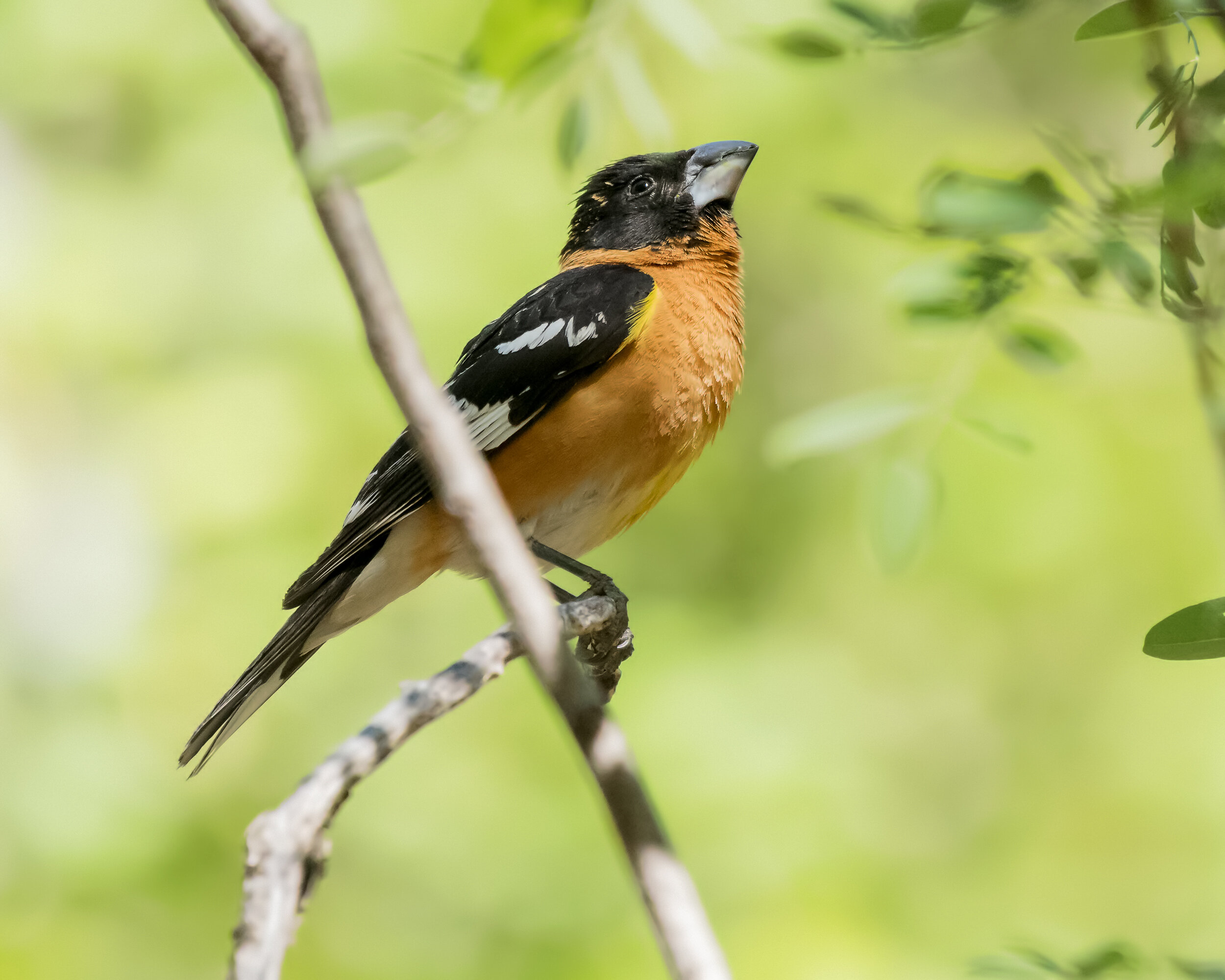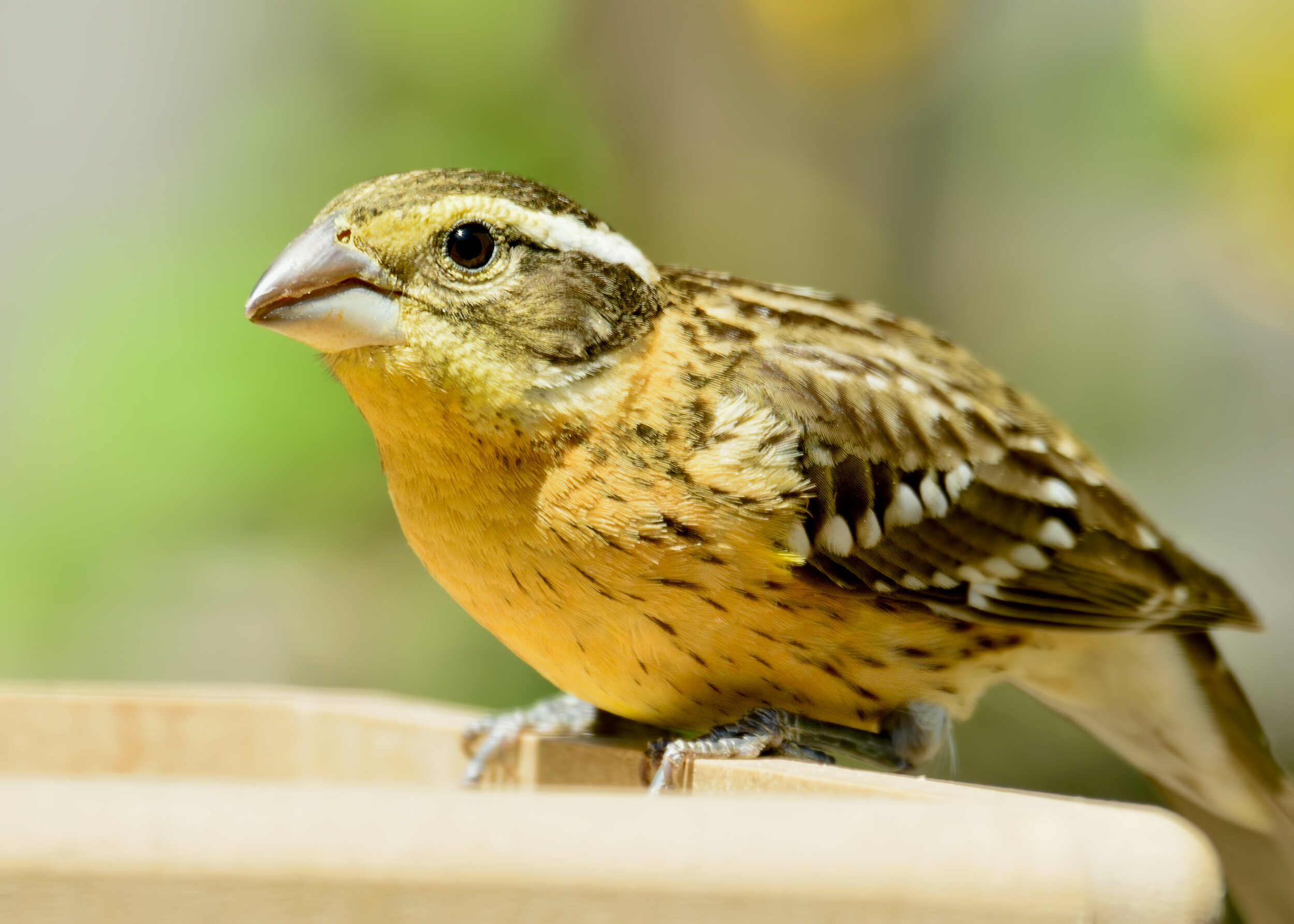Black-headed Grosbeak, adult male, Image by Daniel Lee Brown
This month, let’s learn about a brilliantly-colored songbird that the Sacramento area welcomes each Spring, the Black-headed Grosbeak. Black-headed Grosbeaks share a bird family (or group) with cardinals and buntings. They are found in the western U.S., southern Canada, and Mexico. Black-headed Grosbeaks are diurnal birds. (They are active in the daytime and rest at night.) They spend the wintertime in Mexico. Some populations remain in Mexico year round; but the majority migrate northward in the Spring. They are short to long distance migrants (birds that travel from one area to another according to the seasons). In the Spring, Male Black-headed Grosbeaks are known to start their migration before females do. After nesting season is over, they usually gather in small flocks, looking for berries and other foods, and then head south before winter comes.
What do Black-headed Grosbeaks look like?
Overall, Black-headed Grosbeaks are chunky birds and are about 8½ inches in length. They are fairly large for songbirds (larger than sparrows) and have thick, large, gray bills that are triangular or conical (cone-like) in shape. The top of the bill is slightly darker than the bottom half.
When in their nesting plumage, the males are especially eye-catching. They have solid black heads, black wings with bright white wing bars and patches, deep-orange chests, yellow bellies, orange sides, neck, and rump areas, and black tails that have splashes of white and have white outer tail feathers. Female birds are not as colorful. They have brown backs with dark streaking, brown wings with white wing bars, light-brownish yellow or light-orange chests, necks and throats, streaked flanks (or sides), and white bellies. Females also have brown heads with white stripes. One white stripe runs above their eye and is called the supercilium. Both males and female birds have yellow underwing linings which can be seen during flight.
Young male Black-headed Grosbeaks do not attain full adult plumage (feather color and design) until they are two years of age. During this time male Black-headed Grosbeaks can have a wide variation in color, as some males develop more adult-looking plumage sooner than others do. It can be difficult to distinguish juvenile males and adult females. First-year males can be brown, have streaking on their bodies, and have striped heads like females; but their chests tend to be more orange than females.
Black-headed Grosbeak, female or juvenile, Image by Daniel Lee Brown
Where do Black-headed Grosbeaks live?
Black-headed Grosbeaks frequently choose to live among deciduous trees (trees that lose leaves annually in the fall) and mixed wooded areas. They also require a good water supply nearby. Black-headed Grosbeaks are found in foothill habitat, forest edges, lakeshores, suburban gardens, urban parks, riverside woods, and even mountainous slopes having a water source. They are seldom seen among conifers (trees having needle-like leaves and cones). Black-headed Grosbeaks will accept human presence and will sometimes nest in residential yards and gardens if there is ample cover.
Black-headed Grosbeak nests are built by the female of a pair. It takes around 3-4 days to build a nest. The nests are frequently located on the outer limbs of trees and bushes along streams, ponds, or swamps. Nests are usually 4- 25 feet high and are well hidden by leaves. They are saucer or cup-shaped and constructed with twigs, rootlets, weeds, flowers, animal hair, and grasses. Black-headed Grosbeak nests are very loosely constructed. This thin nest structure may act to keep the eggs cool by allowing good air circulation during warm weather.
The male and female spend equal time both incubating the eggs (sitting on eggs and keeping them warm) and feeding the young after they hatch. The young birds start to climb out of the nest around 11-14 days after hatching; but aren’t able to fly for two more weeks. Usually the fledglings (young birds that have left the nest) are in nearby trees and wait for their parents to bring them insects. A Black-headed Grosbeak pair usually only has one brood (a group of young birds that hatch around the same time) per year. Males tend to migrate south earlier than females do. The female alone continues to feed the fledged young until they learn to find enough food on their own.
Black-headed Grosbeak, adult male, Image by Mary Forrestal
What do Black-headed Grosbeaks eat?
While Black-headed Grosbeaks move around inside the branches and leaves of trees and shrubs, they search for insects and fruits to eat. Occasionally, they will look for food on the ground or catch insects in mid-air. While in Mexico during the Winter, Black-headed Grosbeaks eat mainly seeds. When they migrate to California, around 60% of their diet is animals (insects, spiders, snails, etc.) and 40% is plant matter. As previously mentioned, all species of grosbeaks have large conical-shaped bills. The extra-long sides of their large bills have strong muscles attached. These muscles allow them to open heavy-walled seeds that many other birds are not able to crack open. Their powerful beaks also let them catch hard-bodied insects such as beetles.
In summer, they will eat caterpillars, grasshoppers, scale insects, wasps, bees, flies, moths, beetles, butterflies, and spiders. Black-headed Grosbeaks are one of the few species of birds that are able to eat the poisonous Monarch butterfly! There is a toxin (or poison) inside Monarch butterflies that comes from the milkweed plants they eat. Black-headed Grosbeaks are able to eat Monarch butterflies because they instinctively know to wait a few days in between Monarch eating sessions. This way the toxin is cleared from their bodies. Monarch butterflies taste very bitter to most birds due to this toxin and they spit them out! Black-headed Grosbeaks, however, find Monarch butterflies quite tasty.
Black-headed Grosbeaks also enjoy both wild and cultivated (grown for crops) fruits such as cherries, crabapples, elderberries, blackberries, raspberries, strawberries, mistletoe berries, and poison oak berries. Black-headed Grosbeaks occasionally eat snails; their strong beaks make it easy for them to crack open the shells. They also eat grain, buds, and seeds. Even though they frequently stay in the upper levels of trees, Black-headed Grosbeaks will readily come to backyard feeders. They seem to be particularly fond of sunflower seeds and will come to suet cakes when placed in yards.
What does the Black-headed Grosbeak sound like?
Some consider the song and calls of Black-headed Grosbeaks to be a sign that Spring has finally come. Unlike some other songbirds, both the male and female Black-headed Grosbeaks sing. The male’s song appears to function primarily to defend a territory or to attract a female. The female’s song is usually a shortened version of the male’s song and appears to aid in communication with both the male and the fledglings. Their song has been described to be like that of an American Robin’s but at a faster pace. It is a flute-like, warble (a constantly changing series of notes). Their call has been described as a crisp pik, sharp eek, or tick sound. Listen to the song and calls of the Black-headed Grosbeak below.



